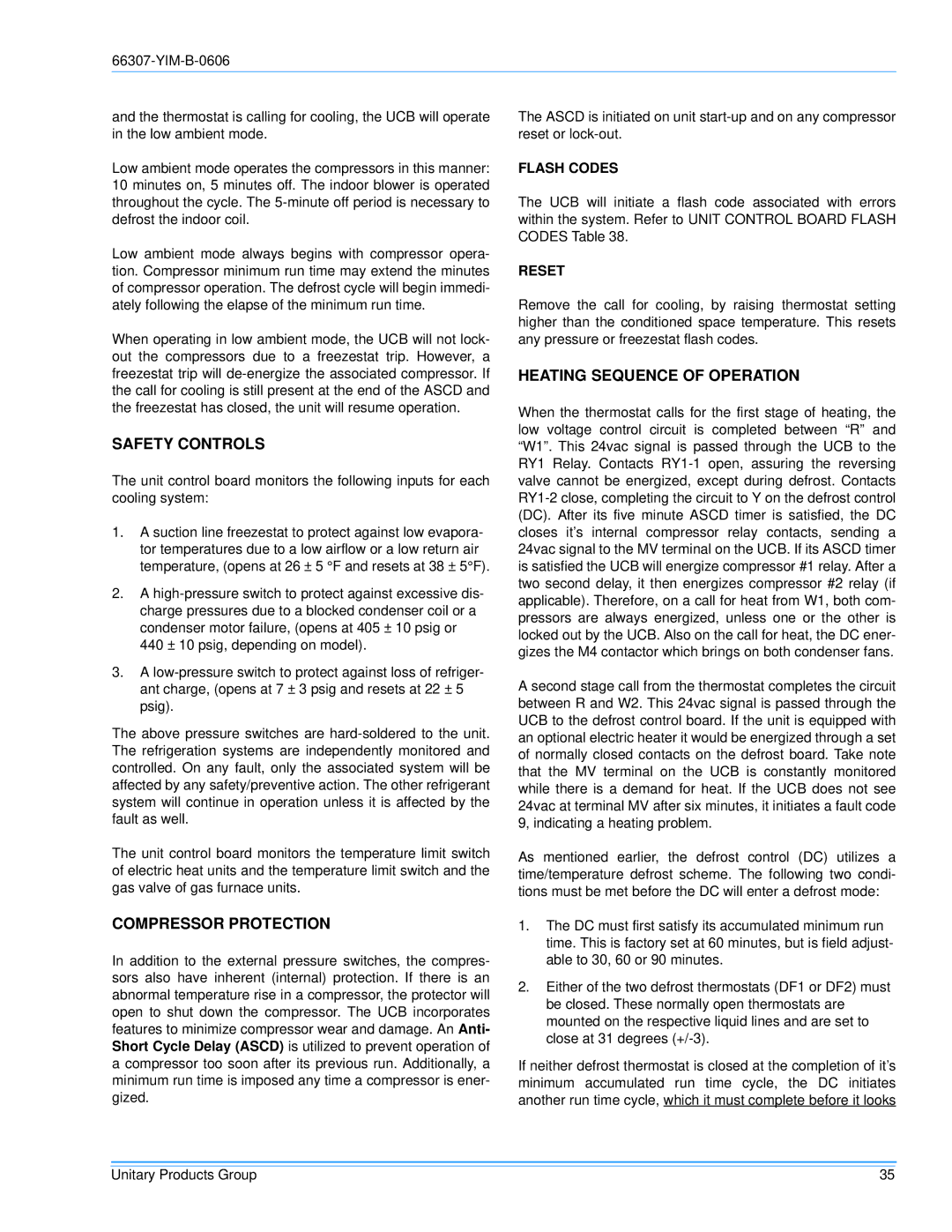
and the thermostat is calling for cooling, the UCB will operate in the low ambient mode.
Low ambient mode operates the compressors in this manner: 10 minutes on, 5 minutes off. The indoor blower is operated throughout the cycle. The
Low ambient mode always begins with compressor opera- tion. Compressor minimum run time may extend the minutes of compressor operation. The defrost cycle will begin immedi- ately following the elapse of the minimum run time.
When operating in low ambient mode, the UCB will not lock- out the compressors due to a freezestat trip. However, a freezestat trip will
SAFETY CONTROLS
The unit control board monitors the following inputs for each cooling system:
1.A suction line freezestat to protect against low evapora- tor temperatures due to a low airflow or a low return air temperature, (opens at 26 ± 5 °F and resets at 38 ± 5°F).
2.A
3.A
The above pressure switches are
The unit control board monitors the temperature limit switch of electric heat units and the temperature limit switch and the gas valve of gas furnace units.
COMPRESSOR PROTECTION
In addition to the external pressure switches, the compres- sors also have inherent (internal) protection. If there is an abnormal temperature rise in a compressor, the protector will open to shut down the compressor. The UCB incorporates features to minimize compressor wear and damage. An Anti- Short Cycle Delay (ASCD) is utilized to prevent operation of a compressor too soon after its previous run. Additionally, a minimum run time is imposed any time a compressor is ener- gized.
The ASCD is initiated on unit
FLASH CODES
The UCB will initiate a flash code associated with errors within the system. Refer to UNIT CONTROL BOARD FLASH CODES Table 38.
RESET
Remove the call for cooling, by raising thermostat setting higher than the conditioned space temperature. This resets any pressure or freezestat flash codes.
HEATING SEQUENCE OF OPERATION
When the thermostat calls for the first stage of heating, the low voltage control circuit is completed between “R” and “W1”. This 24vac signal is passed through the UCB to the RY1 Relay. Contacts
A second stage call from the thermostat completes the circuit between R and W2. This 24vac signal is passed through the UCB to the defrost control board. If the unit is equipped with an optional electric heater it would be energized through a set of normally closed contacts on the defrost board. Take note that the MV terminal on the UCB is constantly monitored while there is a demand for heat. If the UCB does not see 24vac at terminal MV after six minutes, it initiates a fault code 9, indicating a heating problem.
As mentioned earlier, the defrost control (DC) utilizes a time/temperature defrost scheme. The following two condi- tions must be met before the DC will enter a defrost mode:
1.The DC must first satisfy its accumulated minimum run time. This is factory set at 60 minutes, but is field adjust- able to 30, 60 or 90 minutes.
2.Either of the two defrost thermostats (DF1 or DF2) must be closed. These normally open thermostats are mounted on the respective liquid lines and are set to close at 31 degrees
If neither defrost thermostat is closed at the completion of it’s minimum accumulated run time cycle, the DC initiates another run time cycle, which it must complete before it looks
Unitary Products Group | 35 |
